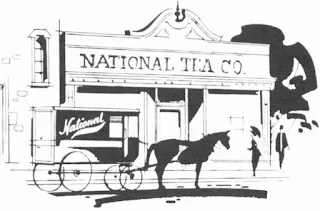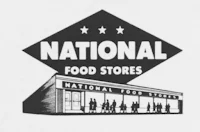Our ninth Food Store Focus covers the National Food Stores chain. It started out with a small market -on Chicago's West North Avenue- on December 9, 1899. George D. Rasmussen and brother Thorvald sold coffee, tea, spices, butter and eggs. The enterprise was quite successful and by 1919, there were 143 National Tea Company stores.
Drawing from the National Tea Company Annual Report 1959A newspaper ad from June 1925 announces the latest specials at the Lincoln Highway (US Route 30) store, in Dekalb, Illinois. At this time, the company was overseeing 761 stores. The peak number would be achieved in 1929, when there were 1,627.
Advert from the National Tea Company
By the early 1930s, units are branded as National Food Stores. There were several different types of stores. The combination Meat & Grocery Market had a full-service meat department, while the Conventional Grocery did not carry meats. The Super Food Store had a meat department and on-site bakery. At the Service Type store, orders were assembled by clerks. Shoppers assembled their orders in Self-Service units.
Photo from the National Tea Company Annual Report 1932
An inside view of a self-service unit, that was described as a (quote-unquote) Complete Food Store. A 1936 count listed 1,221 stores, with 477 of these being combination Meat & Grocery units.
Photo from the National Tea Company Annual Report 1936
National Food Stores started expanding by acquisition at an early date. Co-Operative Stores of America, with eighty-eight units, came under the National corporate umbrella in November 1921.
Graphic from the National Tea Company
By the company's 40th anniversary, in 1939, its store total had dropped to 1,073. Operations now covered the states of Iowa, Illinois, Indiana, Michigan, Minnesota, North Dakota, South Dakota and Wisconsin. The struggling chain was acquired by printing industry maven John F. Cuneo in 1945, who immediately installed Harvey V. McNamara as Executive Vice President. McNamara's business acumen turned the failing enterprise around. He became company president in 1946.
Graphic from the National Tea Company
This trademark was introduced in 1948. At that time, there were 659 stores, with 569 being combination Meat & Grocery units. These operated in the eight states mentioned above. The Indianapolis-based Standard Grocery Company was acquired by National in September 1947. Standard stores would continue to operate under their original nameplate.
Graphic from the National Tea Company
National expanded exponentially in the 1950s. The following chains were acquired; C.F. Smith {Detroit} (April 1952), Piggly Wiggly Northwest {Duluth} (April 1952), George T. Smith Market Baskets {Lansing} (July 1952), Dole Super Markets {Detroit} (July 1952), Food Center Stores {St. Louis} (May 1953), Capitol Stores {Baton Rouge} (February 1954), H.A. Smith Markets {Port Huron, MI} (September 1955) and Fred Montesi {Memphis (October 1955).
Photo from the National Tea Company Annual Report 1950
Acquisitions continued into the 1950s. The following were also bought; Makers of Marshall {Marshall, MI} (April 1956), Makers of Albion {Albion, MI} (April 1956), Tom Maker {Charlotte. MI} (April 1956), Edenton-Lamb {Jackson, TN} {May 1956), Miller's Super Markets {Denver} (May 1957), Tolerton & Warfield {Sioux City} (July 1957), Logan's {Nashville} (October 1957), De Van Horner {Mobile} (October 1957), Illinois Valley Stores {Peoria} (January 1958), Del Farm Foods {Chicago} (August 1958) and Kalamazoo Market Baskets {Kalamazoo} (September 1958).
Graphic from the National Tea Company Annual Report 1954
In January 1956, the National conglomerate was purchased by a joint venture headed by Toronto's W. Garfield Westin (owner of Loblaw's Groceterias Company). By the 60th anniversary of National -in 1959- there were 910 stores. These conducted business in the following states; Alabama, Arkansas, Colorado, Illinois, Indiana, Iowa, Louisiana, Michigan, Minnesota, Mississippi, Missouri, Nebraska, Ohio, South Dakota, Tennessee, Wisconsin and Wyoming. The chain was now the nation's fifth-largest grocery-selling enterprise.
Graphic from the National Tea Company
The company did not expand appreciably during the 1960s. At the beginning of the decade, it was overseeing 897 stores. By 1969, this total had fallen to 800. The 1970s began with 954 stores. This economically brutal decade saw the company losing 36 million dollars in fiscal 1973. A wave of store closings reduced this total to 500 by late 1974. Seventy-five percent of National Stores were sold in 1976, with the chain now operating only in Illinois, Indiana, Louisiana, Minnesota and Missouri.
Photo from the National Tea Company Annual Report 1965
Graphic from the National Tea Company
NATIONAL FOOD STORES JUNIOR-ANCHORED SHOPPING MALLS:
*GOLF MILL CENTER, Niles, IL (1960)
*SOUTH COUNTY CENTER, St. Louis County, MO (1963)
*SOUTH COUNTY CENTER, St. Louis County, MO (1963)
*THE MALL, Huntsville, AL (1966)
















